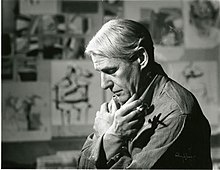Willem de Kooning | |
|---|---|
 De Kooning in his studio in 1961 | |
| Born | April 24, 1904 Rotterdam, Netherlands |
| Died | March 19, 1997 (aged 92) East Hampton, New York[1] |
| Nationality | Dutch, American |
| Known for | Abstract expressionism |
| Notable work | Woman I, Easter Monday, Attic, Excavation |
| Spouse | |
| Awards | Presidential Medal of Freedom (1964) Edward MacDowell Medal (1975) National Medal of Arts (1986) Praemium Imperiale (1989) |
| Signature | |
Willem de Kooning (/də ˈkuːnɪŋ/ də KOO-ning,[2] Dutch: [ˈʋɪləm də ˈkoːnɪŋ]; April 24, 1904 – March 19, 1997) was a Dutch-American abstract expressionist artist. Born in Rotterdam, in the Netherlands, he moved to the United States in 1926, becoming a US citizen in 1962.[3] In 1943, he married painter Elaine Fried.
In the years after World War II, De Kooning painted in a style that came to be referred to as abstract expressionism or "action painting", and was part of a group of artists that came to be known as the New York School. Other painters in this group included Jackson Pollock, Elaine de Kooning, Lee Krasner, Franz Kline, Arshile Gorky, Mark Rothko, Hans Hofmann, John Ferren, Nell Blaine, Adolph Gottlieb, Anne Ryan, Robert Motherwell, Philip Guston, Clyfford Still, and Richard Pousette-Dart. De Kooning's retrospective held at MoMA in 2011–2012 made him one of the best-known artists of the 20th century.[4]
- ^ Cite error: The named reference
grovewas invoked but never defined (see the help page). - ^ Cite error: The named reference
dictwas invoked but never defined (see the help page). - ^ Cite error: The named reference
anbwas invoked but never defined (see the help page). - ^ McGlynn, Tom (June 5, 2019). "De Kooning: Five Decades". The Brooklyn Rail. Retrieved February 25, 2020.